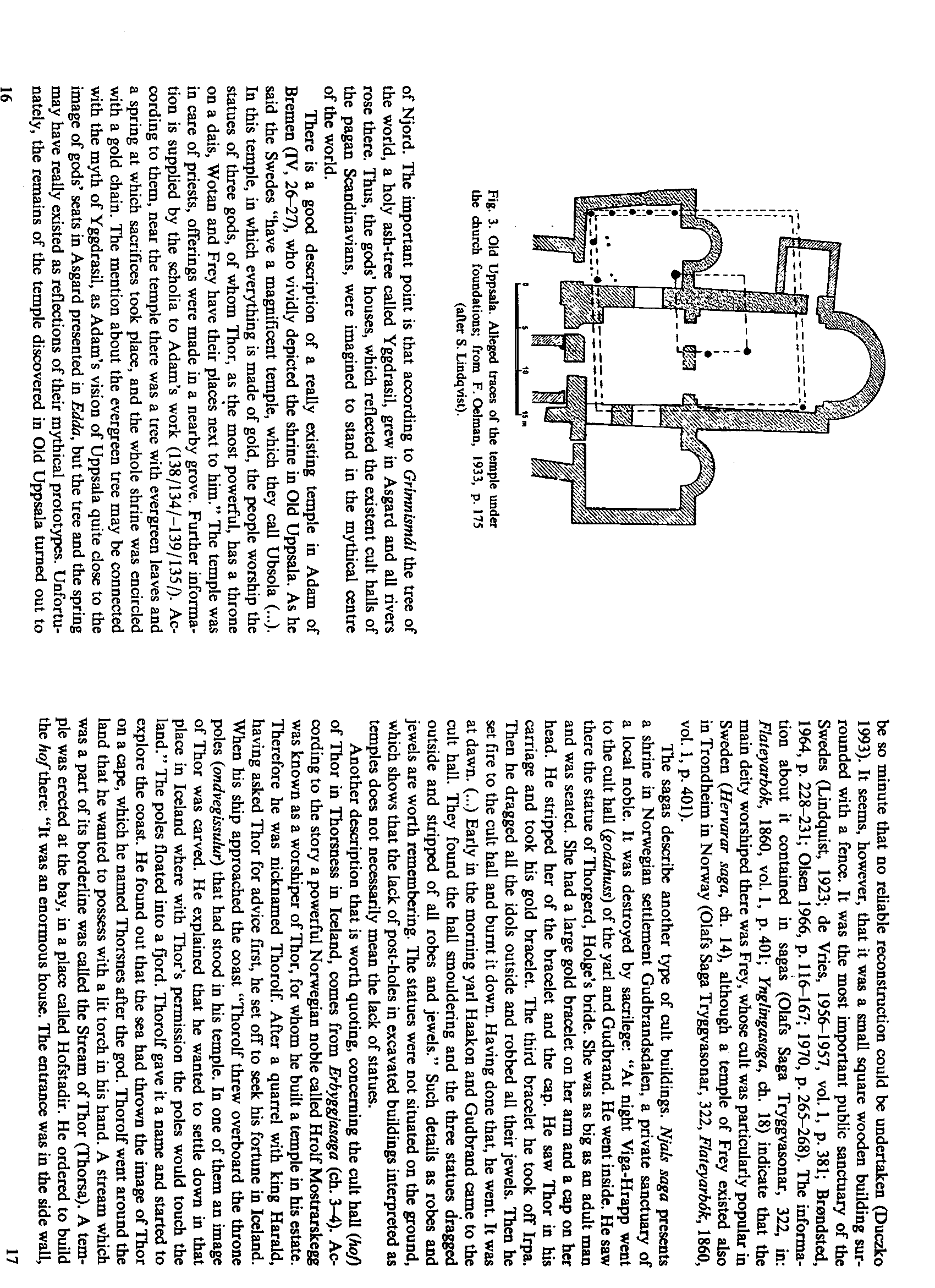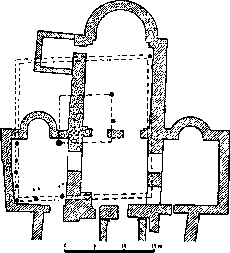image007


Fig. 3. Old Uppsala. Alteged traces of the tempie under the church foundations; from F. Oelraan, 1933, p. 175 (after S. Lindqvist).
of Njord. The important point is that according to Grimnismól the tree of the world, a holy ash-tree called Yggdrasil, grew in Asgard and all rivers rosę there. Thus, the gods’ houses, which reflected the existent cult halls of the pagan Scandinavians, were imagined to stand in the mythical centre of the world.
There is a good description of a really existing tempie in Adam of Bremen (IV, 26-27), who vividly depicted the shrine in Old Uppsala. As he said the Swedes “have a magnificent tempie, which they cali Ubsola (...). In this tempie, in which everything is madę of gold, the people worship the statues of three gods, of whom Thor, as the most powerful, has a throne on a dais, Wotan and Frey have their places next to him.” The tempie was in care of priests, oflerings were madę in a nearby grove. Further informa-tion is supplied by the scholia to Adam’s work (138/134/—139/135 /). According to them, near the tempie there was a tree with evergreen leaves and a spring at which sacrifices took place, and the whole shrine was encircled with a gold chain. The mention about the evergreen tree may be connected with the myth of Yggdrasil, as Adam’s vision of Uppsala quite close to the image of gods’ seats in Asgard presented in Edda, but the tree and the spring may have really existed as reflections of their mythical prototypes. Unfortu-nately, the remains of the tempie discovered in Old Uppsala tumed out to be so minutę that no reliable reconstruction could be undertaken (Duczko 1993). It seems, however, that it was a smali square wooden building sur-rounded with a fence. It was the most important public sanctuary of the Swedes (Lindquist, 1923; de Vries, 1956-1957, vol. 1, p. 381; Brondsted, 1964, p. 228-231; Olsen 1966, p. 116-167; 1970, p. 265-268). The informa-tion about it contained in sagaś (Olafs Saga Tryggvasonar, 322, in: Flaleyarbók, 1860, vol. 1, p. 401; Ynglingasaga, ch. 18) indicate that the main deity worshiped there was Frey, whose cult was particularly popular in Sweden (Hervarar saga, ch. 14), although a tempie of Frey existed also in Trondheim in Norway (Olafs Saga Tryggvasonar, 322, Flateyarbók, 1860, vol. 1, p. 401).
The sagas describe another type of cult buildings. Njals saga presents a shrine in Norwegian settlement Gudbrandsdalen, a private sanctuary of a local noble. It was destroyed by sacrilege: “At night Viga-Hrapp went to the cult hall (godahuss) of the yarl and Gudbrand. He went inside. He saw there the statuę of Thorgerd, Holge’s bride. She was as big as an adult mar; and was seated. She had a large gold bracelet on her arm and a cap on her head. He stripped her of the bracelet and the cap. He saw Thor in his carriage and took his gold bracelet. The third bracelet he took off Irpa. Then he dragged all the idols outside and robbed all their jewels. Then he set fire to the cult hall and bumt it down. Having done that, he went. It was at dawn. (...) Early in the moming yarl Haakon and Gudbrand came to the cult hall. They found the hall smouldering and the three statues dragged outside and stripped of all robes and jewels.” Such details as robes and jewels are worth remembering. The statues were not situated on the ground, which shows that the lack of post-holes in excavated buildings interpreted as temples does not necessarily mean the lack of statues.
Another description that is worth ąuoting, concerning the cult hall (hof) of Thor in Thorsness in Iceland, comes from Erbyggjasaga (ch. 3-4). Ac-cording to the story a powerful Norwegian noble called Hrolf Mostrarskegg was known as a worshiper of Thor, for whom he built a tempie in his estate. Therefore he was nicknamed Thorolf. After a quarrel with king Harald, having asked Thor for advice first, he set off to seek his fortunę in Iceland. When his ship approached the coast “Thorolf threw overboard the throne poles (ondvegissulur) that had stood in his tempie. In one of them an image of Thor was carved. He explained that he wanted to settle down in that place in Iceland where with Thor’s permission the poles would touch the land.” The poles floated into a fjord. Thorolf gave it a name and started to explore the coast. He found out that the sea had thrown the image of Thor on a cape, which he named Thorsnes after the god. Thorolf went around the land that he wanted to possess with a lit torch in his hand. A stream which was a part of its borderline was called the Stream of Thor (Thorsa). A tempie was erected at the bay, in a place called Hofstadir. He ordered to build the hof there: “It was an enormous house. The entrance was in the side wali,
17
Wyszukiwarka
Podobne podstrony:
image055 Fig. 39. Starigard (Oldenburg). The sanctuary erected after the destruction of the church i
image002 TWO COMPLETE NOYELS 35c Duel Of The Spocę WizardsTHESESTARSI jPOUL ANDERSON c &
File0008 Hi! I m Martin l m 17 years old and Tm looking for e-mail friends of the same age from
UN DEBAT : LES MENTALITES COLLECTIYES Fig. ‘J. Paintings od the outer wali of the church at RSęinari
1 100 000 Ryc. 10. Typy siedliskowe lasu w granicach opracowania Fig. 10. Forest habitat typcs of th
CCF20100223�016 Fig. 38a. English
image087 p. 97, 257-258, 312). We can assume that the name of the peak resulted from the ritual of w
DSC08236 (2) Eptatretus Petromyzon $qualus Fig. 3J. A. morphołogy and raterrelaiionships of the duce
DSCF0017 ESSAYS IN SWEDISH HI8TORY brigade, as he eventually developed it, shows traces of the influ
Old English Dialects 1. North of the Humber River was Northumbrian. This was the d
16 JACEK LECH Fig. 15. Sećovce, Trebi.fov dist. The analysis of the archaeological materials from th
CCF20100223�016 Fig. 38a. English
Lawrence Keppie The Making of the Roman Army, From Republic to Empire (1998) >4ĘFf ł f#ir • ■
więcej podobnych podstron